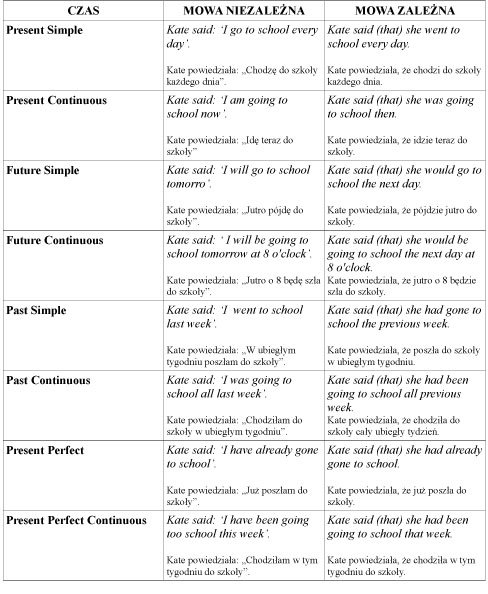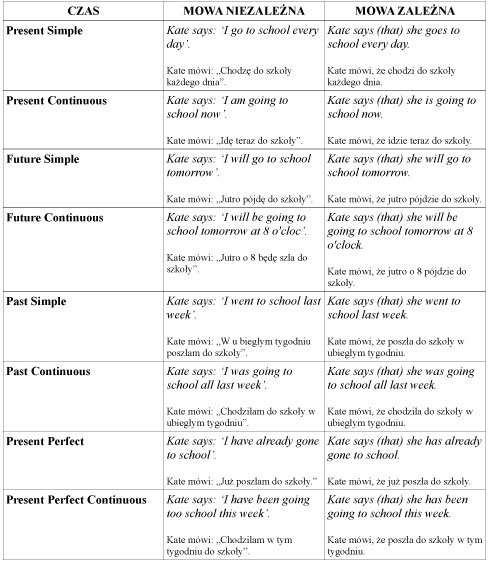Jak i kiedy stosujemy mowę zależną
W języku angielskim mamy dwa sposoby wyrażania tego, co chcemy powiedzieć: mowa zależna (Indirect Speech) i mowa niezależna (Direct Speech). Mowa niezależna to bezpośrednie cytowanie wypowiedzi osób trzecich:
- Kate said: ‘I want something to drink’ - Kate powiedziała: 'Chcę coś do picia'
Natomiast mowa niezależna polega na wiernym oddaniu tego co ktoś powiedział:
Kate said that she wanted something to drink. - Kate powiedziała, że chce coś do picia.
W języku angielskim charakteryzuje się ona pewnymi regułami, a mianowicie czas zdania oryginalnej wypowiedzi musi się zmienić na "jeden czas do tyłu", jest to następstwo czasów. Należy także pamiętać o odpowiedniej zamianie zaimków.
Kate said: ‘ I will show you something’ – Kate said that she would show me something.
Poniższe zmiany zachodzą jeżeli czasownik w zdaniu nadrzędnym (reporting verb) (Kate said) jest w czasie PAST SIMPLE lub PAST PERFECT.
Kate said: ‘I want something to drink’ zamieniamy tak: Kate said that she wanted something to drink
- Zamiana "na jeden czas do tyłu":
Present Simple na Past Simple
Present Continuous na Past Continuous
Future Simple na Future in the Past
Future Continuous na Future Continuous in the Past
Past Simple na Past Perfect
Past Continuous na Past Perfect Continuous
Present Perfect na Past Perfect
Present Perfect Continuous na Past Perfect Continuous
‘I like ice-cream’ said the girl — The girl said that she liked ice-cream
Oprócz zmiany czasów zachodzą jeszcze następujące zmiany:
now — then
today — that day
tonight — that night
tomorrow — the next/following day
next week/month — the following week/month
yesterday — the day before/the previous day
....(3) days ago —...(3) days before
last month/week — the month/week before
this — that
these — those
here — there
‘ I lived here two years ago’. he said — He said that he had lived there two years before.
W języku polskim czas w zdaniu podrzędnym nie zmienia się.

Zmiany nie występują, jeśli czasownik ten (reporting verb) jest w czasie PRESENT SIMPLE, FUTURE SIMPLE lub PRESENT PERFECT.
- Kate says: ‘I want something to drink’ zostaje tak: Kate says that she wants something to drink

- THAT w zdania w mowie zależnej zostało zapisane w nawiasach, gdyż jest opcjonalne i może być opuszczone.
- Zamiast czasownika say możemy zastosować: think, know, suppose, hope, believe, tell i inne sugerujące wypowiadanie zdania.